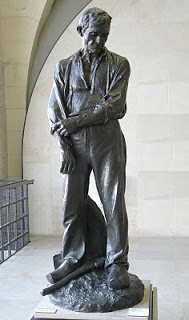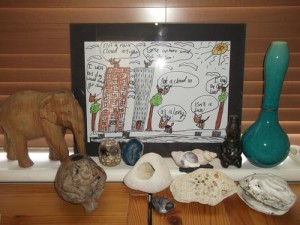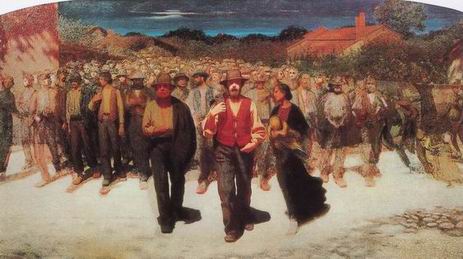You have no items in your cart. Want to get some nice things?
Go shoppingI suspect that every writer’s desk has a tide-mark of stuff arranged around its periphery, totemic objects that connect us in some way to our writing. I have noticed that writers’ totems often seem to be in media that are non-verbal and independent of text, most frequently visual art or tactile objects.
 The poet Selima Hill once described going for long walks along the Dorset coastline as part of her creative process, collecting stones and shells or any interesting object that caught her eye along the way. For poet and novelist Vanessa Gebbie the inspiration for her first novel, The Coward’s Tale, set in a Welsh mining village, was a larger than life bronze statue, Dalou’s Le Grand Paysan which stands in the Musee D’Orsay in Paris.
The poet Selima Hill once described going for long walks along the Dorset coastline as part of her creative process, collecting stones and shells or any interesting object that caught her eye along the way. For poet and novelist Vanessa Gebbie the inspiration for her first novel, The Coward’s Tale, set in a Welsh mining village, was a larger than life bronze statue, Dalou’s Le Grand Paysan which stands in the Musee D’Orsay in Paris.
As a surrogate, Gebbie acquired a much smaller bronze replica of a similar statue, Picciole’s In Labore Benedictio, to connect her to her story. More recently novelist Suzanne Joinson, a lover of street markets, in an essay for BBC Radio 3, likened writers to magpies, their eyes always drawn to the shiny thing that might one day seed a story. For Joinson, inspiration for her debut, The Lady Cyclist’s Guide to Kashgar, came from an 18th century missionary map.
 My own desk is home to an assortment of objects including South American clay pots, weathered beach stones, drawings by my daughter, a turquoise vase with crackle glaze that looks, close up, like the layout of a city seen by satellite.
My own desk is home to an assortment of objects including South American clay pots, weathered beach stones, drawings by my daughter, a turquoise vase with crackle glaze that looks, close up, like the layout of a city seen by satellite.
None of these are connected with a particular story. They are simply part of my writing space. But I have noticed that when I write there is often one object that I focus on for that particular piece of work. For me, so far, it has always been an image. Gebbie, who also teaches creative writing, echoes my experience: ‘Although I can’t say I’ve always had some object or image catalyse every piece I’ve written, I have noticed that the visual is usually, for me, the most successful prompt from which a story will emerge.’
For the last year I’ve had propped up against my study wall an etching of a street scene by Indian artist Pradnya Zate which I came across by chance in Mumbai and bought on the spot. The instant I saw it something about it made me think of the world of my second novel which at the time was still brewing in my head.
 A while ago I wrote a post for my publisher’s blog about a painting that had unexpectedly inspired my first novel, Esperanza Street. The painting was Guiseppe Da Volpedo’s Fiumana, an Italian neo-impressionist painting about a protest march by agricultural workers.
A while ago I wrote a post for my publisher’s blog about a painting that had unexpectedly inspired my first novel, Esperanza Street. The painting was Guiseppe Da Volpedo’s Fiumana, an Italian neo-impressionist painting about a protest march by agricultural workers.
I had encountered Fiumana at the Brera Museum in Milan years before I even conceived of writing Esperanza Street. I was riveted by it. The painting reminded me of a novel, of the way individual narrative threads come together to make a whole. I came away with a postcard that barely does the original justice. The postcard stayed pinned above my desk for years. One might wonder what the connection could be between an Italian painting from 1896 and a book set in 1980’s Philippines, but looking back I can see quite clearly the resemblance between the composition of the painting and that of my novel, though I wasn’t consciously aware of its influence while writing the book.
Professor Jane Rogers, whose tenth novel, Conrad and Eleanor, comes out in June 2016 and whose work has won multiple awards over a very prestigious career, has this to say: ‘I have a number of beloved objects which I keep on the windowsill above my writing desk: a little wooden frog my son brought back from Madagascar; two tiny bronze women made by my sister Helen; a clay echidna sent by my Mum from Australia; a wooden snail whose curly shell is made from a violin given to my daughter when she was three by a good friend who is a violin maker. I often stare at them while I’m concentrating on writing. I don’t think any of them specifically connect me to any one of my stories; it is more that I think of them as part of the landscape while I’m writing, and in a way they are talismans. I have a lot of pebbles too. I love the shapes and feel of smooth pebbles and I do pick them up and fill my pockets wherever I go. The pebbles are probably the most useful while I’m writing because there are a few favourites which I like to hold and turn in my hand as I’m thinking and trying to move on with a story. I suppose they are rather like worry beads, only bigger.’
Rogers says that though her short stories are often inspired by a single event or image, or something she has read, it’s more common for a physical object from her life to take up residence in a story and make the story real for her. ‘For example, when I was commissioned to write a story about Alan Turing (‘Morphogenesis’, which appears in my collection Hitting Trees With Sticks) I needed a scene between the teenage Turing and the boy he loved, Chris. I found a way of anchoring that in reality by having him present Chris with a fircone from his pocket, using it to demonstrate a mathematical point. The real fircone was sitting on my windowsill at the time, and looking at it carefully and focussing on it gave me the way into the scene.
Rogers suspects, as do I, that most writers collect and use totemic objects in this way and do it quite instinctually. Whether a totem is the original seed of a story or simply a method of drawing what is still not manifest out into the real world probably doesn’t matter all that much. Any tool a writer can use to inspire and create work is worth exploring.
About Niyati Keni
Niyati Keni’s first novel, Esperanza Street, was released by indie literary press, Andotherstories, in February 2015. Described by Kirkus Reviews as a ‘luminous, revelatory study on the connection between person and place’, Esperanza Street is set in a small-town community in pre-EDSA revolution Philippines. Keni studied medicine in London and still practices part-time as a physician. She has travelled extensively within Asia. She graduated with distinction from the MA Writing at Sheffield Hallam University in 2007. She is now based in the south east of England where she is working on her second novel.




